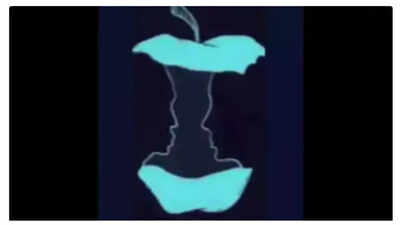Optical illusions continue to captivate audiences, providing a fun and engaging way to test our observational skills. These visual puzzles challenge our brains, offering insight into how we perceive the world around us. An optical illusion arises when our brain misinterprets information received from our eyes, leading to a perception that differs from reality.

The image above, recently shared on social media by Marina Winberg, presents a classic dual-illusion. At first glance, viewers may perceive either an eaten apple or two faces. According to Winberg, your initial perception can reveal a fundamental aspect of your personality. Take a moment to carefully examine the image and determine what you see first.
Winberg explains that the image depicts "two faces (a man and a woman) looking at each other OR an apple core—what you notice first says a lot about your mindset!”
What does your initial perception reveal about you?
If you see the two faces first:
According to Winberg, perceiving the two faces first indicates that “You’re a logical, analytical thinker with strong morals. You think before you act, value stability, and solve problems creatively— but sometimes, curiosity gets the best of you!”
If you saw the apple first:
Winberg suggests that seeing the apple core first means “You’re intuitive, emotionally aware, and great at reading subtle cues. You know the right thing to say, but often stay quiet. Stability matters to you, and you protect what’s important.”
There are three primary categories of optical illusions:
Literal Illusions: These illusions occur when the brain pieces together elements of an image to form something that is not actually present. The apple/faces illusion is a prime example, where the image can be interpreted in two distinct ways.
Physiological Illusions: These illusions result from overstimulation of the visual system, often due to intense exposure to light, movement, or color. Common effects include afterimages and motion illusions.
Cognitive Illusions: These illusions are rooted in the brain's subconscious interpretation of information. The Müller-Lyer illusion, where lines appear to vary in length based on surrounding shapes, exemplifies this type of illusion.
Newer articles
Older articles
 Daren Sammy Fined, Handed Demerit Point for Umpire Criticism After Test Match Comments
Daren Sammy Fined, Handed Demerit Point for Umpire Criticism After Test Match Comments
 Gavaskar Calls for Yadav's Inclusion, Questions Middle Order After India's Test Defeat
Gavaskar Calls for Yadav's Inclusion, Questions Middle Order After India's Test Defeat
 Decoding Your Health: Spotting 5 Prediabetes Warning Signs Before a Blood Test
Decoding Your Health: Spotting 5 Prediabetes Warning Signs Before a Blood Test
 X Corp. Cracks Down: Half a Million Indian Accounts Suspended for Policy Breaches
X Corp. Cracks Down: Half a Million Indian Accounts Suspended for Policy Breaches
 Headline:
Early Warning Signs: 5 Heart Attack Symptoms to Watch Out For Weeks in Advance
Headline:
Early Warning Signs: 5 Heart Attack Symptoms to Watch Out For Weeks in Advance
 Facial Icing: Benefits, Risks, and Safe Application of This Viral Beauty Trend
Facial Icing: Benefits, Risks, and Safe Application of This Viral Beauty Trend
 Chess Sensation Praggnanandhaa Joins Magnus Carlsen's Team Liquid for Esports World Cup
Chess Sensation Praggnanandhaa Joins Magnus Carlsen's Team Liquid for Esports World Cup
 Mastering JPG to PDF Conversion: A Graphic Designer's Guide to Quality and Efficiency
Mastering JPG to PDF Conversion: A Graphic Designer's Guide to Quality and Efficiency
 MI New York's Tajinder Dhillon Shines: From IPL Benchwarmer to MLC Star
MI New York's Tajinder Dhillon Shines: From IPL Benchwarmer to MLC Star
 Akmal Blasts PCB's Interim Coach Choice: Ex-Cricketer Questions Logic Behind Mahmood Appointment
Akmal Blasts PCB's Interim Coach Choice: Ex-Cricketer Questions Logic Behind Mahmood Appointment